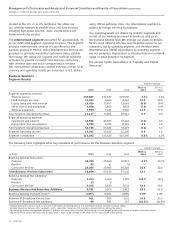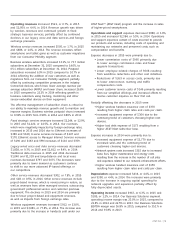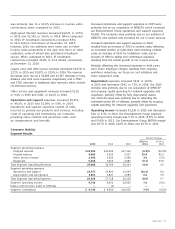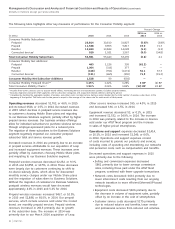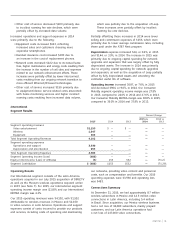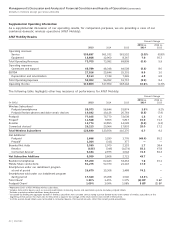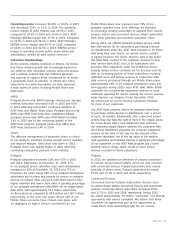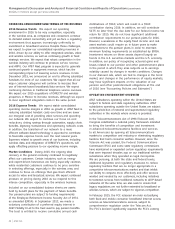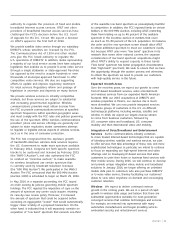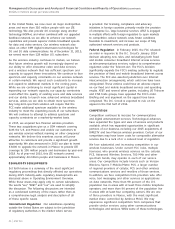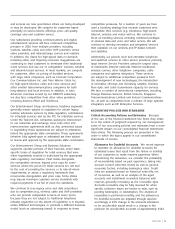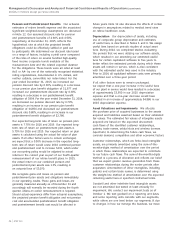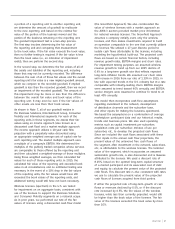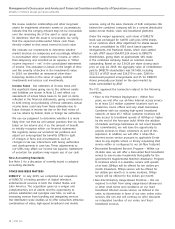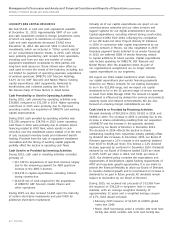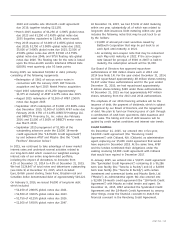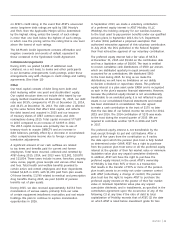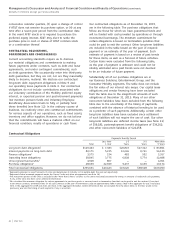AT&T Wireless 2015 Annual Report Download - page 26
Download and view the complete annual report
Please find page 26 of the 2015 AT&T Wireless annual report below. You can navigate through the pages in the report by either clicking on the pages listed below, or by using the keyword search tool below to find specific information within the annual report.
Management’s Discussion and Analysis of Financial Condition and Results of Operations (continued)
Dollars in millions except per share amounts
24
|
AT&T INC.
is provided. Our licensing, compliance and advocacy
initiatives in foreign countries primarily enable the provision
of enterprise (i.e., large business) services. AT&T is engaged
in multiple efforts with foreign regulators to open markets
to competition, reduce network costs, foster conditions
favorable to investment, and increase our scope of fully
authorized network services and products.
Federal Regulation In February2015, the FCC released
an order in response to the D.C.Circuit’s January2014
decision adopting new rules, and reclassifying both fixed
and mobile consumer broadband Internet access services
as telecommunications services, subject to comprehensive
regulation under the Telecom Act. The FCC’s decision
significantly expands the FCC’s existing authority to regulate
the provision of fixed and mobile broadband Internet access
services. The FCC also asserted jurisdiction over Internet
interconnection arrangements, which until now have been
unregulated. These actions could have an adverse impact
on our fixed and mobile broadband services and operating
results. AT&T and several other parties, including USTelecom
and CTIA trade groups, have appealed the FCC’s order.
Briefing and oral argument on the appeal have been
completed. The D.C.Circuit is expected to rule on the
appeal in the first half of 2016.
COMPETITION
Competition continues to increase for communications
and digital entertainment services. Technological advances
have expanded the types and uses of services and products
available, which has expanded opportunities in significant
portions of our business, including our 2015 acquisitions of
DIRECTV and two Mexican wireless providers. Certain of our
competitors may have lower costs for comparable alternative
services due to a lack of or a reduced level of regulation.
We face substantial and increasing competition in our
wireless businesses. Under current FCC rules, multiple
licensees, who provide wireless services on the cellular,
PCS, Advanced Wireless Services, 700 MHz and other
spectrum bands, may operate in each of our service
areas. Our competitors include brands such as Verizon
Wireless, Sprint, T-Mobile/Metro PCS, a larger number
of regional providers of cellular, PCS and other wireless
communications services and resellers of those services.
In addition, we face competition from providers who offer
voice, text messaging and other services as applications
on data networks. More than 98percent of the U.S.
population live in areas with at least three mobile telephone
operators, and more than 94percent of the population live
in areas with at least four competing carriers. We are one
of three providers in Mexico, with the most significant
market share controlled by América Móvil. We may
experience significant competition from companies that
provide similar services using other communications
technologies and services. While some of these technologies
In the United States, we now cover all major metropolitan
areas and more than 310 million people with our LTE
technology. We also provide 4G coverage using another
technology (HSPA+), and when combined with our upgraded
backhaul network, we are able to enhance our network
capabilities and provide superior mobile broadband speeds
for data and video services. Our wireless network also
relies on other GSM digital transmission technologies for
3G and 2G data communications. As of December31,2015,
we served more than 128million U.S.subscribers.
As the wireless industry continues to mature, we believe
that future wireless growth will increasingly depend on
our ability to offer innovative video and data services
and a wireless network that has sufficient spectrum and
capacity to support these innovations. We continue to face
spectrum and capacity constraints on our wireless network
in certain markets. We expect such constraints to increase
and expand to additional markets in the coming years.
While we are continuing to invest significant capital in
expanding our network capacity, our capacity constraints
could affect the quality of existing voice and data services
and our ability to launch new, advanced wireless broadband
services, unless we are able to obtain more spectrum.
Any long-term spectrum solution will require that the
FCC make additional spectrum available to the wireless
industry to meet the expanding needs of our subscribers.
We will continue to attempt to address spectrum and
capacity constraints on a market-by-market basis.
In 2015, we acquired two Mexican wireless providers.
These two acquisitions give us a GSM network covering
both the U.S. and Mexico and enable our customers to
use wireless services without roaming on other companies’
networks. We believe this seamless access will prove
attractive to customers and provide a significant growth
opportunity. We also announced in 2015 our plan to invest
$3,000 to upgrade the network in Mexico to provide LTE
coverage to 100million people and businesses by year-end
2018. As of year-end 2015, this LTE network covered
approximately 44million people and businesses in Mexico.
REGULATORY DEVELOPMENTS
Set forth below is a summary of the most significant
regulatory proceedings that directly affected our operations
during 2015. Industry-wide regulatory developments are
discussed above in Operating Environment Overview.
While these issues may apply only to certain subsidiaries,
the words “we,” “AT&T” and “our” are used to simplify
the discussion. The following discussions are intended
as a condensed summary of the issues rather than as
a comprehensive legal analysis and description of all
of these specific issues.
International Regulation Our subsidiaries operating
outside the United States are subject to the jurisdiction
of regulatory authorities in the market where service


